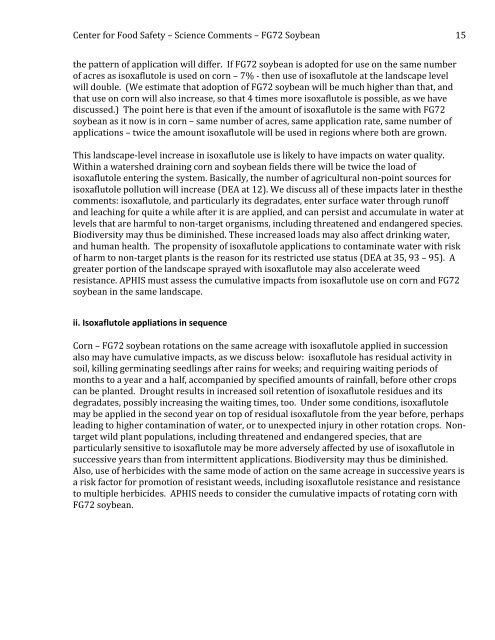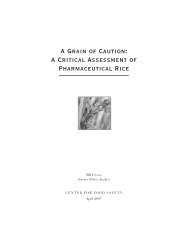a four-fold rise - Center for Food Safety
a four-fold rise - Center for Food Safety
a four-fold rise - Center for Food Safety
Create successful ePaper yourself
Turn your PDF publications into a flip-book with our unique Google optimized e-Paper software.
<strong>Center</strong> <strong>for</strong> <strong>Food</strong> <strong>Safety</strong> – Science Comments – FG72 Soybean <br />
15 <br />
the pattern of application will differ. If FG72 soybean is adopted <strong>for</strong> use on the same number <br />
of acres as isoxaflutole is used on corn – 7% -‐ then use of isoxaflutole at the landscape level <br />
will double. (We estimate that adoption of FG72 soybean will be much higher than that, and <br />
that use on corn will also increase, so that 4 times more isoxaflutole is possible, as we have <br />
discussed.) The point here is that even if the amount of isoxaflutole is the same with FG72 <br />
soybean as it now is in corn – same number of acres, same application rate, same number of <br />
applications – twice the amount isoxaflutole will be used in regions where both are grown. <br />
This landscape-‐level increase in isoxaflutole use is likely to have impacts on water quality. <br />
Within a watershed draining corn and soybean fields there will be twice the load of <br />
isoxaflutole entering the system. Basically, the number of agricultural non-‐point sources <strong>for</strong> <br />
isoxaflutole pollution will increase (DEA at 12). We discuss all of these impacts later in thesthe <br />
comments: isoxaflutole, and particularly its degradates, enter surface water through runoff <br />
and leaching <strong>for</strong> quite a while after it is are applied, and can persist and accumulate in water at <br />
levels that are harmful to non-‐target organisms, including threatened and endangered species. <br />
Biodiversity may thus be diminished. These increased loads may also affect drinking water, <br />
and human health. The propensity of isoxaflutole applications to contaminate water with risk <br />
of harm to non-‐target plants is the reason <strong>for</strong> its restricted use status (DEA at 35, 93 – 95). A <br />
greater portion of the landscape sprayed with isoxaflutole may also accelerate weed <br />
resistance. APHIS must assess the cumulative impacts from isoxaflutole use on corn and FG72 <br />
soybean in the same landscape. <br />
ii. Isoxaflutole appliations in sequence <br />
Corn – FG72 soybean rotations on the same acreage with isoxaflutole applied in succession <br />
also may have cumulative impacts, as we discuss below: isoxaflutole has residual activity in <br />
soil, killing germinating seedlings after rains <strong>for</strong> weeks; and requiring waiting periods of <br />
months to a year and a half, accompanied by specified amounts of rainfall, be<strong>for</strong>e other crops <br />
can be planted. Drought results in increased soil retention of isoxaflutole residues and its <br />
degradates, possibly increasing the waiting times, too. Under some conditions, isoxaflutole <br />
may be applied in the second year on top of residual isoxaflutole from the year be<strong>for</strong>e, perhaps <br />
leading to higher contamination of water, or to unexpected injury in other rotation crops. Non-target<br />
wild plant populations, including threatened and endangered species, that are <br />
particularly sensitive to isoxaflutole may be more adversely affected by use of isoxaflutole in <br />
successive years than from intermittent applications. Biodiversity may thus be diminished. <br />
Also, use of herbicides with the same mode of action on the same acreage in successive years is <br />
a risk factor <strong>for</strong> promotion of resistant weeds, including isoxaflutole resistance and resistance <br />
to multiple herbicides. APHIS needs to consider the cumulative impacts of rotating corn with <br />
FG72 soybean.







